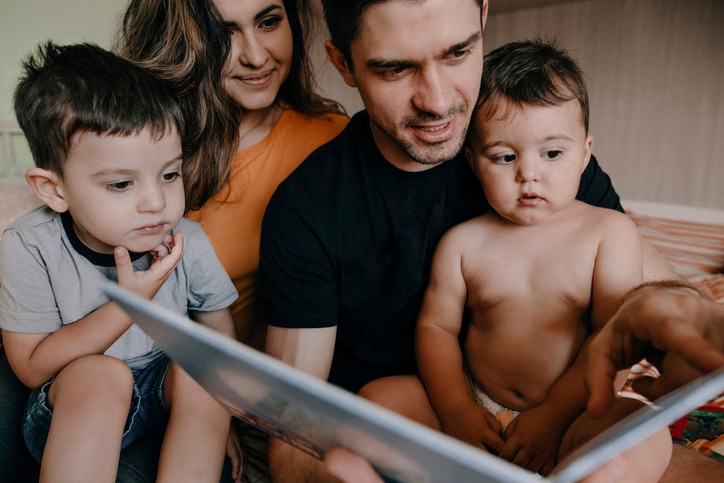With the rise in popularity of language learning apps, many parents these days are finding themselves studying a second language right alongside their school-aged kids. In fact, at the start of 2023, 30% of adults said they were planning to learn to speak a new language. But what age is best for taking up a foreign language, and who has a better chance at success: kids, teens or adults?
Experts believe that in adolescence, people’s ability to speak new languages at a native-equivalent level tends to gradually diminish as their native language takes root, which has an impact on a second language. It may also have something to do with how the brain is wired at a younger age. However, this varies among individuals — so there’s no reason not to try!
So what’s the best age to learn a new language? The earlier the better, according to psychology and education experts. Here, we take a look at the latest research, some top tips for language learners in early life, plus the cognitive benefits of language learning in childhood.
What’s the best age to learn a new language?
Experts agree that there is a clearly defined “critical period” for language acquisition, or a period of life when it is easiest to learn a language. According to the latest critical period hypothesis research, this time extends from birth until age 18, which is longer than previously thought. However, it can be best to learn a new language by the age of 10 if kids are aiming to achieve the fluency of a native speaker — and the sooner they start, the better their chances. The earlier kids start practising skills and techniques like pronunciation, the more likely they are to grasp them well.
Language learning early in life has a wider benefit beyond the cognitive, too: it helps kids discover different perspectives. Exploring new cultures, places and modes of communication through a new language is a great way to introduce children to the existence of other ways of being, thinking and living in the world.
At one point, there was a fear that exposing infants and toddlers to more than one language could delay speech development. But that myth has been disproved. In fact, most bilingual children speak their first words by age 1 and use two-word phrases by age 2, which are the same developmental milestones for children learning only one language. Four in 10 people worldwide are bilingual, and bilingualism is increasingly believed to have cognitive and developmental benefits, rather than leading to language disorders or otherwise holding children back.
Why it’s easier for young children to learn a new language
There are any number of potential reasons why younger children find it easier to pick up another language. Here are a few:
Native language interference
Interference from one’s native language is the impact of a child’s first language on speech and language processing. The younger the child and the less familiar they are with their native language, the less likely this is to occur.
Immersive learning environments
There are also contextual factors that may make it easier for children to learn a second language, especially when they are moving to a new country. Communicating and using the language in the real world seems to be more advantageous than book learning when it comes to picking up a new language. We might study the fundamentals, but the best way to develop fluency is to use it in practice — something children, with their hands-on approach to learning and discovering the world, are adept at doing.
Natural motivation
High-immersion environments such as school and educational institutions are places where children have a clear motivation to learn their new language. The more readily they can express themselves, the easier it is for them to socialise with other children, make friends and thrive. This can help them pick up the language more quickly and practise more. By contrast, adults are often less likely to be in such situations when acquiring a second language or to have that level of motivation.
The benefits of starting to learn a second language in early childhood
When working out what age is best to learn a language, it’s worth considering the many benefits of starting language instruction between the ages of 2 and 5:
Development of a more natural accent
At a young age, children are still exploring the phonemes, or sounds of letters, in their mother tongue. Adding new phonemes from a second language into the mix early on, when kids are more open to learning these crucial linguistic building blocks, can help their brains and bodies adapt to making the new sounds. This is a great base on which to build the ability to reproduce an accent.
Ease of learning
The standard for most language instruction at any age is to aim for the class to be led at least 90% in the target language. However, immersion techniques like this may be more effective in early childhood due to the natural confidence children have to speak words they don’t know. Older children and teens are keen to fit in with their peers and are more likely to fear the judgement or criticism associated with trying new things and getting them wrong. They may also be more aware of their relative limitations in the new language as compared to their first one. This is one reason why it can be best to learn a new language before the age of 10.
Quick tips for getting your child started with a second language
Choosing a language that your little one will be exposed to as much as possible in early childhood is the best way to set them up for success. Learning a language and maintaining a certain level is easier when there are frequent opportunities to practice through communication and play. Immersion in the new linguistic context is one of the most common tips for language learners. It’s a good idea for parents to opt for a language that their child has access to in their daily life, whether it’s offered at a school that offers second-language instruction or in the care of a bilingual babysitter or nanny.
At home, it can be helpful for parents to use the target language as much as possible, rather than relying on videos or TV. For parents who are just getting started, one useful resource is “A Parents’ and Teachers’ Guide to Bilingualism”, which provides advice on how to raise bilingual kids.
The bottom line
The best age to start learning a new language is during the first years of life. However, it’s still possible for kids to effectively learn a language well into their teenage years, so parents shouldn’t be discouraged if their child gets a later start. While our brains are wired to pick up things like pronunciation more readily at a young age, we can continue our language learning journeys with grammar, vocabulary and expressions — and can reap the cognitive benefits of language learning throughout the rest of our lives.

